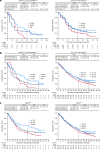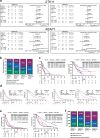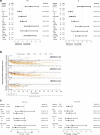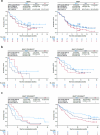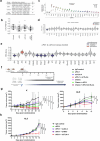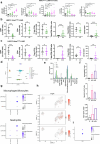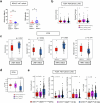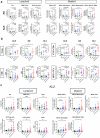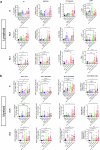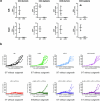Competing interests F.S. reports consulting for AstraZeneca, Amgen, Revolution Medicines, Novartis, BridgeBio, Beigene, BergenBio, Guardant Health, Calithera Biosciences, Tango Therapeutics, Hookipa Pharma, Novocure, Merck Sharp & Dohme, Roche; grant or research support from Amgen, Mirati Therapeutics, Revolution Medicines, Pfizer, Novartis, Merck & Co; stockholder in BioNTech, Moderna; and honoraria from ESMO, Japanese Lung Cancer Society, Medscape, Intellisphere, VSPO McGill Universite de Montreal, RV Mais Promocao Eventos, MJH Life Sciences, IDEOlogy Health, MI&T, PER, CURIO, DAVA Oncology, the American Association for Cancer Research and the International Association for the Study of Lung Cancer. M.M. reports stockholder in Roche Holdings. N.J. reports shareholder and former employee of Pionyr Immunotherapeutics. J.M.J. reports stock of D2G Oncology. C.M., Y.Y., X.P. and A.H. report employee of Tango Therapeutics. K.C.A. reports personal fees from Sanofi Genzyme and other support from Revolution Medicines, Genentech, and Mirati outside the submitted work. N.V. receives consulting fees from Sanofi Genzyme, Oncocyte, Eli Lilly, Regeneron, and research funding to the institution from Mirati, Oncocyte, and Circulogene, outside the submitted work. P.D.P. reports advisory fees from AstraZeneca and Jazz Pharmaceuticals. M.E.M. reports research funding from Eli Lilly (Inst), AstraZeneca (Inst), Merck (Inst), Genentech (Inst); consulting role with AstraZeneca, Novocure, Boehringer Ingelheim, Janssen, Takeda, Blueprint Pharmaceuticals, Bayer, Bristol Myers Squibb, Ikena; honorarium from Thermo Fisher Scientific; and stock in Merck, Johnson & Johnson. M.M.A. reports grants and personal fees from Genentech, Bristol Myers Squibb and AstraZeneca; grants from Lilly; and personal fees from Maverick, Blueprint Medicine, Syndax, Nektar, Gritstone, ArcherDX, Mirati, NextCure, Novartis, EMD Serono and Panvaxal/NovaRX, outside of the submitted work. J.C.M. reports consulting or honoraria: MJH Life Sciences, Johnson & Johnson and Doximity; and research funding (to institution): Merck via the Conquer Cancer Foundation. J.F.G. reports served as a compensated consultant or received honoraria from Bristol Myers Squibb, Genentech (Roche), Takeda, Loxo (Lilly), Blueprint Medicine, Gilead, Moderna, AstraZeneca, Mariana Therapeutics, Mirati, Jounce, Merus Pharmacueticals, Nuvalent, Pfizer, Novocure, AI Proteins, Novartis, Merck, iTeos, Karyopharm and Silverback Therapeutics; research support from Novartis, Genentech (Roche) and Takeda; institutional research support from Bristol Myers Squibb, Palleon, Tesaro, Moderna, Blueprint, Jounce, Array Biopharma, Merck, Adaptimmune, Novartis and Alexo; has equity in AI Proteins; and has an immediate family member who is an employee with equity at Ironwood Pharmaceuticals. A.D. reports honoraria: Intellisphere, Roche (Genentech); ad board: TP Therapeutics, Guardant Health, AnHeart Therapeutics, ChromaCode; clinical trial support: Syntrix Pharmaceuticals, Novartis, Merck, AnHeart Therapeutics, Sorrento Therapeutics, Guardant Health and Philogen. C. M. Bestvina reports consulting or advisory role: AstraZeneca, Genentech, AbbVie, Curio Science, OncLive Clinical Congress Consultants, Seagen, Creative Educational Concepts, Takeda, Janssen, CVS, Bristol Myers Squibb (Celgene), Jazz Pharmaceuticals, Novartis, Sanofi–Regeneron and Novocure; speakers’ bureau: Merck; research funding: Bristol Myers Squibb and AstraZeneca. C.A.S. reports advisory boards to AstraZeneca, Gilead, Janssen, Genentech, Mirati, Takeda and Arcus Biosciences. J.W.R. reports honoraria or consulting (self): Boehringer Ingelheim, BMS, Turning Point Roche (Genentech), Biodesix, EMD Serono, Daiichi Sankyo, Blueprint, Novartis, Regeneron, Sanofi, Janssen, Jazz Pharmaceuticals, Bayer, Beigene, Merus and Seagen; research support (to institution): ArriVent, Merck, Novartis, AstraZeneca, Spectrum, Revolution Medicines, IO Biotech and Kinnate. C. M. Blakely reports research funding: AstraZeneca, Novartis, Mirati, Spectrum, Takeda, Puma and Pfizer; and consulting: Janssen and Bayer. C.V.P. reports a founder and equity and intellectual property in EnFuego Therapeutics. F.T. reports speaker bureau or honoraria: Roche, AstraZeneca, Novartis and Takeda. M.S. reports institutional support: Dracen Pharmaceuticals; advisory board: Amgen, AstraZeneca, Boehringer Ingelheim, Janssen Pharmaceuticals, Novartis, Pfizer, Roche, Sanofi-Aventis, Siemens Healthineers, Takeda Pharmaceuticals and Bristol Myers Squibb; leadership or fiduciary role: ESMO and EORTC. S.D. reports independent image analysis for hospital-contracted clinical research trials programs for Merck, Pfizer, Bristol Myers Squibb, Novartis, Roche, Polaris, Cascadian, Abbvie, Gradalis, Bayer, Zai laboratories, Biengen, Resonance and Analise; research grants from Lunit, GE, Qure AI; and an honorarium from Siemens. M.J.M. reports AstraZeneca, Bristol Myers Squibb and Istari Oncology & Regeneron. A.G.S. reports AstraZeneca, Genentech (Roche) and Bristol Myers Squibb. A.N.S. reports serving as a consultant and/or advisory board member for Eli Lilly, Daiichi Sankyo and Zymeworks; and research funding from Eli Lilly, Novartis, Daiichi Sankyo, Genentech, AstraZeneca, Memgen, Mersana, Turning Point Therapeutics, BioAtla and Genmab to his institution. J.R. reports consulting fees or honoraria from AstraZeneca, Takeda, Sanofi Genzyme, Genentech, Guardant Health, Summit, G1 Therapeutics, BioAtla, Jazz, Amgen, and Janssen; contracted for research (institutional) with AstraZeneca, BioAtla, Blueprint Medicines, EpimAb Biotherapeutics, LOXO Oncology, Enliven, Redcloud and ORIC. T.S. reports advisory board or consulting fees for Seagen, Astellas and AstraZeneca; and research grant GRAIL. S.B.G. reports research funding from AstraZeneca, Boehringer Ingelheim and Mirati; and consulting or advisory board member for AstraZeneca, Boehringer Ingelheim, Bristol Myers Squibb, Genentech, Amgen, Blueprint Medicine, Sanofi Genzyme, Daiichi Sankyo, Takeda, Janssen, Summit Therapeutics, Merck and Regeneron. J.K. reports for Arterys. K.S. reports consultant, advisor or speaker for Clinica Alemana Santiago, Shattuck Labs, AstraZeneca, EMD Serono, Takeda, Torque/Repertoire Therapeutics, CSRlife, Agenus, Genmab, OnCusp, Parthenon Therapeutics, Bristol Myers Squibb, Roche, Molecular Templates, Abbvie, Sanofi, Merck, PeerView, PER and Forefront Collaborative; research funding from Navigate BP, Tesaro/GSK, Moderna, Takeda, Surface Oncology, Pierre-Fabre, Merck, Bristol Myers Squibb, AstraZeneca, Ribon Therapeutics, Eli Lilly, Boehringer Ingelheim, Genentech (Roche) and Akoya Biosciences. K.D.D. reports consulting fees or other remuneration from Rain Therapeutics. V.A. reports research funding to Johns Hopkins University from AstraZeneca and Personal Genome Diagnostics, has received research funding to Johns Hopkins University from Bristol Myers Squibb and Delfi Diagnostics in the past five years and is an advisory board member for Neogenomics and AstraZeneca. V.A. is an inventor on patent applications (63/276,525, 17/779,936, 16/312,152, 16/341,862, 17/047,006 and 17/598,690) submitted by Johns Hopkins University related to cancer genomic analyses, ctDNA therapeutic response monitoring and immunogenomic features of response to immunotherapy that have been licensed to one or more entities. Under the terms of these license agreements, the University and inventors are entitled to fees and royalty distributions. K.A.M. reports consulting or advisory fees from AstraZeneca, Amgen, Janssen, Mirati Therapeutics, Daiichi Sankyo (Lilly) and Puma Biotechnology, as well as honoraria from AstraZeneca. K.A.M. receives research funding to Johns Hopkins University from Bristol Myers Squibb and Mirati Therapeutics. P.M.F. reports consulting fee (for example, advisory board): Ascendis, AstraZeneca, BMS, Curevac, Novartis, Regeneron, G1, Genelux, Genentech, Gritstone, Merck, Janssen, F-Star, Sanofi, Amgen, Fosun, Teva, Synthekine, Flame, Iteos, Tavotek and Teva; contracted research: AstraZeneca, BMS, Novartis, Regeneron and BioNTech. B.R. reports advisory board or consultant: Regeneron, AstraZeneca, Amgen; honoraria: Targeted Oncology. E.M.V.A reports advisory or consulting: Tango Therapeutics, Genome Medical, Genomic Life, Enara Bio, Manifold Bio, Monte Rosa, Novartis Institute for Biomedical Research, Riva Therapeutics and Serinus Bio; research support: Novartis, BMS and Sanofi; equity: Tango Therapeutics, Genome Medical, Genomic Life, Syapse, Enara Bio, Manifold Bio, Microsoft, Monte Rosa, Riva Therapeutics and Serinus Bio; patents: institutional patents filed on chromatin mutations and immunotherapy response, and methods for clinical interpretation; intermittent legal consulting on patents for Foaley & Hoag; editorial boards: JCO Precision Oncology and Science Advances. A.L.C. reports consulting for AstraZeneca, Merus and Tempus; research funds from AstraZeneca, Genentech (Roche), Merck and Novartis. J.W.G. reports research grants: AstraZeneca, BMS, Eli Lilly, Genentech, Merck and Pfizer; consulting fees: AstraZeneca, BMS, Genentech, Gilead, Gritstone, Eli Lilly, Pfizer and Regeneron. C.A. reports consulting or advisory role: Genentech, Lilly, Celgene, Merck, AstraZeneca, Blueprint Genetics, Shionogi, Daiichi Sankyo–AstraZeneca, Sanofi/Regeneron, Eisai, BeiGene, Turning Point Therapeutics, Pfizer, Janssen, Boehringer Ingelheim; research funding: Genentech/Roche (Inst), Incyte (Inst), Macrogenics (Inst), Merck Sharp & Dohme (Inst) and AstraZeneca–MedImmune (Inst). L.R. reports honoraria: Merck, AstraZeneca, Genzyme, EMD Serono and Astellas Pharmas; consulting or advisory role: Amgen. J.W.N. reports honoraria: CME Matters, Clinical Care Options CME, Research to Practice CME, Medscape CME, Biomedical Learning Institute CME, MLI Peerview CME, Prime Oncology CME, Projects in Knowledge CME, Rockpointe CME, MJH Life Sciences CME, Medical Educator Consortium, HMP education consulting or advisory role: AstraZeneca, Genentech (Roche), Exelixis, Takeda Pharmaceuticals, Eli Lilly, Amgen, Iovance Biotherapeutics, Blueprint Pharmaceuticals, Regeneron Pharmaceuticals, Natera, Sanofi, D2G Oncology, Surface Oncology, Turning Point Therapeutics, Mirati Therapeutics, Gilead Sciences, Abbive, Summit Therapeutics, Novartis, Novocure, Janssen Oncology, Anheart Therapeutics Research Funding: Genentech (Roche), Merck, Novartis, Boehringer Ingelheim, Exelixis, Nektart Therapeutics, Takeda Pharmaceuticals, Adaptimmune, GlaxoSmithKline, Janssen Pharmaceuticals, Abbvie Pharmaceuticals and Novocure. Y.Y.E. reports honoraria: CME Matters, Clinical Care Options CME, Research to Practice CME, Medscape CME, Biomedical Learning Institute CME, MLI Peerview CME, Prime Oncology CME, Projects in Knowledge CME, Rockpointe CME, MJH Life Sciences CME, Medical Educator Consortium, HMP education consulting or advisory role: AstraZeneca, Genentech (Roche), Exelixis, Takeda Pharmaceuticals, Eli Lilly, Amgen, Iovance Biotherapeutics, Blueprint Pharmaceuticals, Regeneron Pharmaceuticals, Natera, Sanofi, D2G Oncology, Surface Oncology, Turning Point Therapeutics, Mirati Therapeutics, Gilead Sciences, Abbive, Summit Therapeutics, Novartis, Novocure, Janssen Oncology, Anheart Therapeutics Reserach Funding: Genentech/Roche, Merck, Novartis, Boehringer Ingelheim, Exelixis, Nektart Therapeutics, Takeda Pharmaceuticals, Adaptimmune, GlaxoSmithKline, Janssen Pharmaceuticals, Abbvie Pharmaceuticals and Novocure. M.V.N. reports research funding to institution: Mirati, Novartis, Checkmate (ended), Alaunos, AstraZeneca, Pfizer, Genentech, Navire; consultant or advisory board: Mirati, Merck/MSD, Novartis and Genentech. X.L. reports receiving consulting or advisory fees from EMD Serono (Merck KGaA), AstraZeneca, Spectrum Pharmaceutics, Novartis, Eli Lilly, Boehringer Ingelheim, Hengrui Therapeutics, Janssen, Blueprint Medicines, Regeneron, Sensei Biotherapeutics, Abion and Abbvie, and research funding from Eli Lilly, EMD Serono, Janssen, ArriVent, Teligene, BlackDiamond, Regeneron and Boehringer Ingelheim. V.K.L. reports consultant or advisory role for Takeda, Seattle Genetics, BMS, AstraZeneca, Guardant Health and AnHeart Therapeutics and has received research funding from GSK, BMS, AstraZeneca, Merck and Seattle Genetics. W.E.L. reports advisory boards: Eisai and Takeda, Grand Rounds and BMS for repotrectinib. J.A.R. reports consultancy, stock, Genprex; patents issued and pending. T.C. reports speaker fees or honoraria from the Society for Immunotherapy of Cancer (SITC), Mark Foundation for Cancer Research, Bristol Myers Squibb, Roche, Medscape, IDEOlogy Health, Physicians’ Education Resource (PER), OncLive and PeerView; travel and/or food/beverage expenses from SITC, International Association for the Study of Lung Cancer, Parker Institute for Cancer Immunotherapy, PER, Dava Oncology, IDEOlogy Health, AstraZeneca and Bristol Myers Squibb; advisory role or consulting fees from MedImmune–AstraZeneca, Bristol Myers Squibb, Merck, Genentech, Arrowhead Pharmaceuticals, Pfizer and Regeneron; and institutional research funding from MedImmune–AstraZeneca, Bristol Myers Squibb and EMD Serono. J.Z. reports grants from Merck, grants and personal fees from Johnson & Johnson and Novartis, personal fees from Bristol Myers Squibb, AstraZeneca, GenePlus, Innovent and Hengrui outside the submitted work. G.R.B. reports grant or contract for clinical trial from MacroGenics; grants from Amgen, Bayer, Adaptimmune, Exelixis, Daiichi Sankyo, GlaxoSmithKline, Immatics, Immunocore, Incyte, Kite Pharma, MacroGenics, Torque, AstraZeneca, Bristol Myers Squibb, Celgene, Genentech, MedImmune, Merck, Novartis, Roche, Sanofi, Xcovery, Tmunity Therapeutics, Regeneron, BeiGene, Repertoire Immune Medicines, Verastem, CytomX Therapeutics and Duality Biologics; consulting fees from AbbVie, Adicet, Amgen, Ariad, Bayer, Clovis Oncology, AstraZeneca, Bristol Myers Squibb, Celgene, Daiichi Sankyo, Instil Bio, Genentech, Genzyme, Gilead, Eli Lilly, Janssen, MedImmune, Merck, Novartis, Roche, Sanofi, Tyme Oncology, Xcovery, Virogin Biotech, Maverick Therapeutics, BeiGene, Regeneron, Cytomx Therapeutics, Intervenn Biosciences and Onconova Therapeutics; participation in advisory boards at Virogin Biotech and Maverick Therapeutics; stock in Virogin Biotech; and employment of family member at Johnson & Johnson/Janssen. C.G. reports member of the advisory board at Jazz Pharmaceuticals, AstraZeneca and Bristol Myers Squibb and served as speaker for AstraZeneca and BeiGene. L.A.B. reports consulting fees and research funding from AstraZeneca, GenMab and Sierra Oncology and research funding from Tolero Pharmaceuticals and served as advisor or consultant for PharmaMar, AbbVie, Bristol Myers Squibb, Alethia, Merck, Pfizer, Jazz Pharmaceuticals, Genentech and Debiopharm Group. D.L.G. reports AstraZeneca, Eli Lilly, Menarini Richerche, 4D Pharma, Onconova Therapeutics and Sanofi. A.T. reports Ariad, AstraZeneca, Bristol Myers Squibb, Boehringer Ingelheim, Eli Lilly, EMD Serono, Genentech, GlaxoSmithKline, Merck, Novartis, Pfizer, Roche, Seattle Genetics, Gilead Sciences and Summit Therapeutics. T.G.B. reports Chan-Zuckerberg Biohub. D.R.C. reports CoI Company sponsored trials at institution (PI roles): AZ, Roche (Genentech) advisory role: ad hoc advisory boards or consultations 2023: Abbvie (steering committee), Anheart, Beigene (IDMC), Eli Lilly (IDMC), Imagene, Immunocore, Janssen, Mirati (IDMC), Prelude, Seattle Genetics, Valencee; 2022: Abbvie, Anheart, Appolomics (SRC), AstraZeneca–Daiichi (ILD adjudication committee), Beigene (DSMB) Dizal, EMD Serono, Elevation, Hengrui, (DSMB), Hummingbird, Janssen, Medtronic, Mersana (ILD adjudication committee), Mirati, Nalo Therapeutics, Onkure, Regeneron, Roche, Sanofi, Takeda, Theseus, Xcovery; 2021: Abbvie, Amgen, Anheart, Apollomics (SRC), AstraZeneca (SRC/SC), Beigene (DSMC), Bio-Thera (DSMB), Blueprint, Daiichi Sankyo (ILD adjudication committee), Elevation (SRC), Eli Lilly (DSMB and NCCN), EMD Serono, Helsinn (DSMB), Hengrui (DSMC), Janssen, Kestrel (SAB, Shares), Mersana, Nuvalent (SAB), Puma (NCCN), Ribon, Roche (Genentech), Sanofi, Seattle Genetics, Takeda and Turning Point. J.E.G. reports honoraria: Jazz Pharmaceuticals, Merck and OncoCyte; consulting or advisory role: AstraZeneca, Blueprint Medicines, Bristol Myers Squibb, EMD Serono, Lilly, Sanofi, Merck Sharp & Dohme, Loxo, Jazz Pharmaceuticals, Novartis, AstraZeneca–MedImmune, Janssen Scientific Affairs, National Comprehensive Cancer Network, AbbVie and Regeneron; research funding: Merck (Inst), AstraZeneca (Inst), Bristol Myers Squibb (Inst), Boehringer Ingelheim (Inst), Genentech (Roche) (Inst), G1 Therapeutics (Inst), Novartis (Inst), Pfizer (Inst), Ludwig Institute for Cancer Research (Inst), SWOG (Inst), Array BioPharma (Inst) and ECOG-ACRIN (Inst). N.L. reports CME and research funding: AstraZeneca. B.L. reports Genentech (Roche), Eli Lilly, Merck, Pfizer, Janssen, Daiichi Sankyo, Takeda, Mirati, Novartis and Guardant 360. J.R.B. reports grant funding: AstraZeneca; advisory board: AstraZeneca, Amgen, Novartis, Incyte, Bristol Myers Squibb, Genentech, Janssen, Sanofi, Regeneron, Merck, GlaxoSmithKline; DSMB: Sanofi, Janssen and GlaxoSmithKline. M.C.G. reports AstraZeneca, Abion, MSD International, Bayer, BMS, Boehringer Ingelheim Italia S.p.A, Celgene, Eli Lilly, Incyte, Novartis, Pfizer, Roche, Takeda, Seattle Genetics, Mirati, Daiichi Sankyo, Regeneron, Merck, Blueprint, Janssen, Sanofi, AbbVie, BeiGenius, Oncohost and Medscape. D.R.G. reports institutional research grants from Amgen, AstraZeneca, Genentech and Merck; consultant or advisory board for Adagene, AstraZeneca, Roche (Genentech), Guardant, IO Biotech, Oncocyte, OncoHost, Lilly, Merck and Novartis. E.B.G. reports consulting or advisory role: Novartis, GlaxoSmithKline, Merck, Boehringer Ingelheim, Shionogi, Eisai, Bristol Myers Squibb, ABL Bio, Xilio Therapeutics, Natera, Sanofi–Regeneron, Lilly, Personalis, Gilead Sciences, AstraZeneca, AbbVie–Abbott, Arcus Biosciences, Seagan and Summit Therapeutics; research funding: Merck (Inst), Genentech (Inst), AstraZeneca (Inst), Novartis (Inst), Lilly (Inst), Bristol Myers Squibb (Inst), Mirati Therapeutics (Inst), Dynavax Technologies (Inst), Iovance Biotherapeutics (Inst), Neon Therapeutics (Inst), EMD Serono (Inst), ABL Bio (Inst) and Daiichi Sankyo–UCB Japan (Inst); patents, royalties, other intellectual property: diagnosistic and therapeutic use of ‘Motif Neoepitopes’ as defined by Cummings et al.76. N.A.R. reports an employee at Synthekine and holds equity at Synthekine and Gritstone. G.V.S. reports honoraria, research funding and personal fees from AstraZeneca, Bayer, BeiGene Switzerland, F. Hoffman–La Roche, Merck Sharpe & Dohme, Eli Lilly, Johnson & Johnson, Pfizer, Takeda Oncology, Tesaro and Verastem outside the submitted work. J.W. reports advisory boards and lecture fees: Amgen, AstraZeneca, Bayer, Blueprint, BMS, Boehringer Ingelheim, Chugai, Daiichi Sankyo, Ignyta, Janssen, Lilly, Loxo, Merck, Mirati, MSD (Merck Sharp & Dohme), Novartis, Nuvalent, Pfizer, Roche, Seattle Genetics, Takeda and Turning Point; research support (to institution): BMS, Janssen, Novartis, Pfizer and AstraZeneca. B.B. reports receiving grants from AbbVie, Amgen, AstraZeneca, Chugai, Daiichi Sankyo, Ellipse, EISAI, Genmab, Genzyme Corporation, Hedera Dx, Inivata, IPSEN, Janssen, MSD, PharmaMar, Roche (Genentech), Sanofi, Socar Research, Tahio Oncology and Turning Point Therapeutics. R.S.H. reports consulting roles with AbbVie Pharmaceuticals, ARMO Biosciences, AstraZeneca, Biodesix, Bolt Biotherapeutics, Bristol Myers Squibb, Cybrexa Therapeutics, eFFECTOR Therapeutics, Eli Lilly, EMD Serono, Genentech (Roche), Genmab, Halozyme Therapeutics, Heat Biologics, I-Mab Biopharma, Immunocore, Infinity Pharmaceuticals, Loxo Oncology, Merck, Mirati Therapeutics, Nektar, Neon Therapeutics, NextCure, Novartis, Oncternal Therapeutics, Pfizer, Sanofi, Seattle Genetics, Shire, Spectrum Pharmaceuticals, STCube Pharmaceuticals, Symphogen, Takeda, Tesaro, Tocagen and WindMIL Therapeutics; advisory board roles with AstraZeneca, Bolt Biotherapeutics, Cybrexa Therapeutics, EMD Serono, I-Mab Biopharma, Immunocore, Infinity Pharmaceuticals, Neon Therapeutics, Novartis and STCube Pharmaceuticals; research support from AstraZeneca, Eli Lilly, Genentech (Roche) and Merck; and non-executive board membership for Junshi Pharmaceuticals and Immunocore. H.A.W. reports grants or contracts from any entity: Bayer, Arrys Therapeutics, AstraZeneca–Medimmune, BMS, Clovis Oncology, Genentech (Roche), Merck, Novartis, Seagen, Xcovery and Helsinn; advisory board: Mirati, Merck and Genentech (Roche); leadership: International Association for the Study of Lung Cancer (IASLC), President; ECOG-ACRIN, executive committee. N.A.P. reports an employee at Synthekine and holds equity at Synthekine and Gritstone. A.T.S. is currently an employee of Novartis. P.A.J. reports stock and other ownership interests: Gatekeeper Pharmaceuticals and Loxo; consulting or advisory role: Pfizer, Boehringer Ingelheim, AstraZeneca, Merrimack, Chugai, Roche (Genentech), Loxo, Mirati Therapeutics, Araxes Pharma, Ignyta, Lilly, Takeda, Novartis, Biocartis, Voronoi Health Analytics, SFJ Pharmaceuticals Group, Sanofi, Daiichi Sankyo, Silicon Therapeutics, Nuvalent, Eisai, Bayer, Syndax, AbbVie, Allorion Therapeutics, Accutar Biotech, Transcenta, Monte Rosa Therapeutics, Scorpion Therapeutics, Merus, Frontier Medicines, Hongyun Biotech and Duality Biologics; research funding: AstraZeneca (Inst), Astellas Pharma (Inst), Daiichi Sankyo (Inst), Lilly (Inst), Boehringer Ingelheim (Inst), Puma Biotechnology (Inst), Takeda (Inst) and Revolution Medicines (Inst); patents, royalties, other intellectual property: I am a co-inventor on a DFCI owned patent on EGFR mutations licensed to Lab Corp. I receive post-marketing royalties from this invention. D.P.C. reports advisory boards or consulting: Abbvie, Arcus Biosciences, AstraZeneca, BMS Israel, G1 Therapeutics, Genentech, GlaxoSmithKline, InThought, Iovance Biotherapeutics, Janssen, Jazz, JNJ, Merck–EMD Serono, Merck KGaA, Mirati, MSD, Novartis, Novocure, OncoHost, Pfizer Egypt, Regeneron, Roche and Sanofi; KOL/presentation/education/forum: AstraZeneca, Curio Science, Intellisphere, Merck US, OncLive, Pfizer, PPD Development and Roche Taiwan. M.D.H. is an employee of and stockholder in AstraZeneca. C.M.R. reports consulted regarding oncology drug development with AbbVie, Amgen, AstraZeneca, D2G, Daiichi Sankyo, Epizyme, Genentech (Roche), Ipsen, Jazz, Kowa, Lilly, Merck and Syros. He serves on the scientific advisory boards of Auron, Bridge Medicines, DISCO, Earli and Harpoon Therapeutics. L.A. is an employee of Foundation Medicine and a stockholder of Roche Holding AG. H.M. reports full-time employee of AstraZeneca and stock/shares. Z.Z. reports employee of AstraZeneca as well as stockholder of AstraZeneca and Pfizer. Z.L. reports full-time employee and stock owner of AstraZeneca. R.S. reports other support from AstraZeneca during the conduct of the study, as well as other support from Pfizer outside the submitted work. S.P. reports consultation or advisory role: AbbVie, Amgen, Arcus, AstraZeneca, Bayer, Beigene, BerGenBio, Biocartis, BioInvent, Blueprint Medicines, Boehringer Ingelheim, Bristol Myers Squibb, Clovis, Daiichi Sankyo, Debiopharm, Eli Lilly, F-Star, Fishawack, Foundation Medicine, Genzyme, Gilead, GSK, Hutchmed, Illumina, Incyte, Ipsen, iTeos, Janssen, Merck Sharp and Dohme, Merck Serono, Merrimack, Mirati, Nykode Therapeutics, Novartis, Novocure, PharmaMar, Promontory Therapeutics, Pfizer, Regeneron, Roche (Genentech), Sanofi, Seattle Genetics and Takeda; Board of Directors position: Galenica; talk in a company’s organized public event: AstraZeneca, Boehringer Ingelheim, Bristol Myers Squibb, Eli Lilly, Foundation Medicine, GSK, Illumina, Ipsen, Merck Sharp and Dohme, Mirati, Novartis, Pfizer, Roche (Genentech), Sanofi and Takeda; receipt of grants or research support: principal investigator in trials (institutional financial support for clinical trials) sponsored by Amgen, Arcus, AstraZeneca, Beigene, Bristol Myers Squibb, GSK, iTeos, Merck Sharp and Dohme, Mirati, PharmaMar, Promontory Therapeutics, Roche (Genentech) and Seattle Genetics. J.M.J. and M.J.R. are employees and shareholders of D2G Oncology. I.P.W. is a co-founder, employee and shareholder of D2G Oncology. M.M.W. is a co-founder, shareholder, member of the board of directors and compensated scientific advisor of D2G Oncology. I.P.W. and M.M.W. are co-inventors of patents relating to technologies for an autochthonous mouse model of human cancer, which D2G Oncology has exclusively licensed from Stanford University. V.A.P. reports Pfizer employee and stockholder. K.K.W. is a founder and equity holder of G1 Therapeutics and has sponsored research agreements with Takeda, TargImmune, Bristol Myers Squibb, Mirati, Merus and Alkermes, and consulting and sponsored research agreements with AstraZeneca, Janssen, Pfizer, Novartis, Merck, Zentalis, BridgeBio and Blueprint. P.J. reports employee and stock or stock options of AstraZeneca. I.I.W. reports honoraria from Genentech (Roche), Bayer, Bristol Myers Squibb, AstraZeneca, Pfizer, Merck, Guardant Health, Flame, Novartis, Sanofi, Daiichi Sankyo, Amgen, Janssen, Merus, G1 Therapeutics, Abbvie, Catalyst Therapeutics, Regeneron, Oncocyte, Medscape, Platform Health and Physicians’ Education Resources; research support from Genentech, Merck, Bristol Myers Squibb, Medimmune, Adaptive, Adaptimmune, EMD Serono, Pfizer, Takeda, Amgen, Karus, Johnson & Johnson, Bayer, Iovance, 4D, Novartis and Akoya. A.G.P. reports Pfizer. J.V.H. reports Advisory Committees: Genentech, Mirati Therapeutics, Eli Lilly, Janssen, Boehringer Ingelheim, Regeneron, Takeda, BerGenBio, Jazz, Curio Science, Novartis, AstraZeneca, BioAlta, Sanofi, Spectrum, GlaxoSmithKline, EMD Serono, BluePrint Medicine and Chugai; research support: AstraZeneca, Boehringer Ingelheim, Spectrum, Mirati, Bristol Myers Squibb and Takeda; licensing or royalties: Spectrum. H.A.A., M.T.D., A.G.C., Y.Q., R.P., D.M., D.H.O., R.M., J.A.H., L.M., S.C.M.L., R.P.J., C.L., Z.W., M.G.W., D.V., H.S., M.K., S.K., Y.N., J.T.A., J.S., L.L., H.N.K., B.C., S.S., R.L., T.Z., J.J.L., D.P., M.L.J. T.T., A.P., Y.K. and J.L.: no disclosures were reported by these authors.

